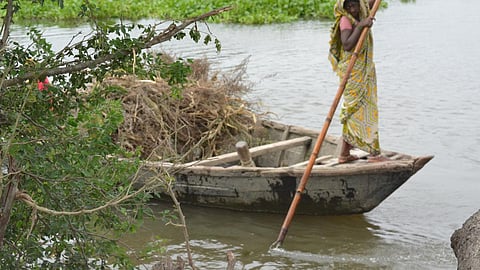
- Topics
- Feature
- Opportunities & Events
- Data
- Hindi Portal
- Topics
- Feature
- Opportunities & Events
- Data
- Hindi Portal

Mahananda, a major River of north Bihar rises in the Darjeeling district of West Bengal. It meets the Ganga after a journey of 376 km through the flat lands of Bihar, West Bengal and Bangladesh. It would spill its banks because of the flat slopes, causing deluge and waterlogging in the Katihar district of Bihar. Additionally, the spills of the abandoned channels of the River Kosi like Barnadi and Kari Kosi, added to the impasse. Mahananda, like other north Bihar rivers, brings a lot of loosely packed geological material from the Himalayas that it deposits in the plains. It also changes its course.
The Hindi book titled 'Bandini Mahananda' deals with the engineering solutions put in place to tackle the issue of floods. The Mahananda Flood Control Scheme was prompted by the Government of West Bengal, and resulted in an embankment (Maliar Beel Bund Scheme) being constructed on the left bank of the river. Embanking one side of a river puts the other side to peril as it gets subjected to increased floods. This prompted technocrats and politicians from Bihar to make a case for an embankment to protect the right bank of the river located in Purnea district of Bihar.
The book discusses how the solution was worse than the problem itself through the case of the Mahananda Flood Control Scheme. It shows how when the flood level rises within the embankments, the lives of the people is threatened. Often, embankments breach on their own. The massive floods of 1987 in Bihar had led to breaching of the Mahananda embankments at 22 places. Because the Scheme led to widespread waterlogging and damage to crops, the locals had no option but to breach the embankments. As early as 1966, the Committee Against Embankments in Mahananda was formed.
Jacketing of the river traps the silt in between the embankments as these rivers bring in a lot of it. The river bed starts rising as a result. Also, tributaries cannot meet the main river because of embankments. Though there are sluice gates to allow the tributaries to feed the waters to the main river, these gates cannot be opened during floods. When opened, the waters from the main river can flow backwards into the tributaries causing floods in the areas adjoining the latter. In 1989, Mahananda’s waters back-flowed into the countryside because a sluice gate developed mechanical trouble causing a lot of problem.
So these careless solutions have in fact led to rainwater getting waterlocked between the embankments of the main river and the tributaries. Many a times, this water needs to be pumped out, the other option being letting the water evaporate or seep through.
This book challenges the engineering view that the embankments lead to an increased river flow velocity and hence more water can be passed through at the same time.